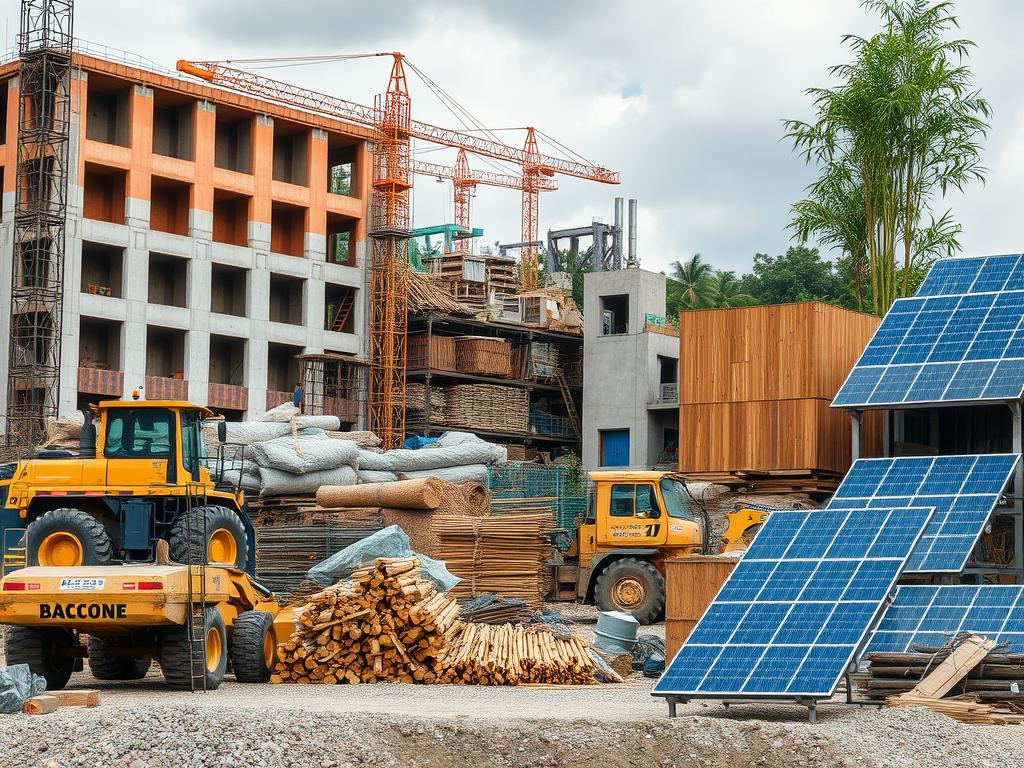Exploring eco-friendly materials shows they do more than follow trends. They are key in building construction, especially with growing environmental awareness. These materials cut down on carbon emissions and make buildings healthier.
The construction world is big, with nearly 50% of global emissions coming from it. Over 20% of these emissions come directly from building. Using eco-friendly materials helps make our planet greener and our buildings last longer.
Studies show green buildings can increase in value by at least 10%. LEED-certified buildings also have lower costs for upkeep and running. This makes using eco-friendly materials a smart choice for a sustainable future.
By choosing these materials, I help create better spaces for people to live and work. It’s a step toward a healthier world for all of us.
Sustainable building practices are essential for reducing the environmental impact of construction projects while minimizing costs and improving energy efficiency. By adopting sustainable building methods, builders can reduce waste, conserve natural resources, and minimize greenhouse gas emissions. This can be achieved through practices such as using recycled materials, minimizing on-site construction waste, and implementing energy-efficient design strategies. Additionally, incorporating features like rainwater harvesting systems, greywater reuse systems, and high-performance insulation can further enhance the environmental benefits of sustainable building.
Green architecture is a vital component of creating eco-friendly buildings that not only minimize environmental harm but also promote occupant health and well-being. By incorporating green building principles into design and construction, architects and builders can create spaces that are healthier, more energy-efficient, and environmentally sustainable. This can be achieved through the use of materials like reclaimed wood, low-VOC paints, and locally sourced materials, as well as innovative systems like green roofs, living walls, and solar panels. By prioritizing green architecture, we can create buildings that not only reduce their carbon footprint but also improve the quality of life for those who inhabit them.
What Are Eco-Friendly Materials?
Eco-friendly materials are key in today’s building world. They are materials that don’t harm the environment and keep people healthy. They help save resources, reduce waste, and use less energy.
Definition and Examples
These materials are good for the planet. They grow back, don’t harm the environment, and have a small footprint. Here are some examples:
- Bamboo: It grows fast, needs little water, and no pesticides.
- Recycled Steel: It’s strong, can be recycled, and lasts a long time.
- Hempcrete: It’s made from hemp, a plant that grows back fast. It’s great for keeping buildings warm or cool.
- Reclaimed Wood: It’s old wood that’s been saved. It’s strong, looks good, and is eco-friendly.
- Freshwater Algae Cladophora: It’s a plant that’s soft like silk. It’s good for buildings and is safe for the environment.
Importance in Today’s Construction Industry
Building green is now a big deal. It’s because we need to fight climate change and protect our planet. Eco-friendly materials help by reducing harmful gases and waste.
Architects and builders are choosing green options more. This is because people want buildings that are good for the planet. Governments are also helping by making rules that support green building.
Using green materials can save money and be more efficient. New technologies make these options better and cheaper. The market for green building materials is growing fast, showing that these choices are becoming more popular.
Environmental Impact of Traditional Materials
Traditional building materials harm the environment a lot. They cause resource depletion and pollution. This damage affects both nature and human health.
Resource Depletion
Traditional materials like sand and gravel harm habitats. Logging destroys forests and reduces biodiversity. Buildings use a lot of energy, making material demand high.
This high demand speeds up resource depletion. It makes resources we need scarce over time.
Pollution and Waste Generation
Creating traditional materials pollutes a lot. Concrete production, for example, is a big source of carbon dioxide. This shows we need better options fast.
Construction also creates a lot of waste. Over 170 tons of debris are made each year. Most of it goes to landfills, taking years to break down.
It also pollutes water. Excess materials and chemicals can harm nearby water sources.
Looking at the harm of traditional materials, we see why we need eco-friendly ones. They help save resources and reduce waste. By choosing green materials, we can make the construction industry better for our planet.
Advantages of Using Eco-Friendly Materials
Exploring construction, I see eco-friendly materials’ big benefits. Switching to these options is good for our planet, health, and wallet. Let’s look at why these materials are key in building today.
Reduced Carbon Footprint
Choosing eco-friendly materials cuts our carbon footprint. Materials like bamboo and recycled steel lower emissions by 20%. They use less energy and resources, fighting climate change. Using them helps our planet for generations to come.
Enhanced Energy Efficiency
Eco-friendly materials make buildings more energy-efficient. For instance, natural fiber windows and insulation cut heating and cooling needs by 15-30%. This saves money and keeps homes cozy. It’s a smart choice for a greener future.
Improved Indoor Air Quality
Eco-friendly materials also improve indoor air. They release fewer harmful chemicals than regular materials. This makes air healthier, especially for those with allergies. It’s a step towards cleaner, safer homes.
Popular Eco-Friendly Materials in Construction
Construction is changing with eco-friendly materials. Bamboo and recycled steel are leading the way. They are strong, last long, and help the planet.
Bamboo
Bamboo grows fast and is very strong. It can grow up to 1.5 inches a day. This means it’s ready to use in just three to five years.
It’s great for flooring and scaffolding. Bamboo makes buildings more eco-friendly.
Recycled Steel
Recycled steel is a big deal in construction. It’s very recyclable and keeps getting stronger. This cuts down on new steel use and pollution.
Using recycled steel in buildings is good for the planet. It supports green building practices.
Bamboo Fiber Insulation
Bamboo fiber insulation is great for keeping buildings warm or cool. It’s good for the environment and saves energy. Using bamboo in insulation makes buildings more efficient.

Economic Benefits of Going Green
Choosing eco-friendly materials has many economic perks. Starting with sustainable building can save money over time. Even though it might cost more at first, the savings later on are big.
Studies show businesses that focus on being green can cut costs by 20% in five years. This not only saves money but also makes things more efficient.
Cost-Effective in the Long Run
Using eco-friendly materials can be a smart financial move. It leads to lower energy bills. Plus, you need to fix things less often, saving even more money.
Businesses in renewable energy can get up to 30% of their costs back through tax credits. This makes going green even more appealing financially.
Increased Property Value
Properties with eco-friendly materials often sell for more. More and more people want to live in green homes. This is good for the environment and for your wallet.
Homes that use less energy sell for higher prices. This is because people see them as valuable and good for the planet. I’ve found that going green is not just smart financially. It also helps the community and the planet.
Challenges in Implementing Eco-Friendly Practices
Starting eco-friendly projects in construction has its own set of challenges. Knowing these obstacles helps us find better ways to build sustainably.
Initial Costs
One big problem is the initial costs of eco-friendly materials. These materials are usually pricier than regular ones. This can make builders hesitant, especially when money is tight.
But, it’s important to remember. The cost upfront might seem high. Yet, saving money on energy and upkeep in the long run makes it worth it.
Availability of Materials
Finding the right materials is another challenge. In some places, green building materials are hard to find. This can make projects take longer and cost more if materials have to be shipped far.
It’s key to look for local suppliers and understand the market. This helps me choose materials that are both sustainable and easy to get.

Case Studies of Successful Eco-Friendly Projects
Looking at eco-friendly projects shows us many new ways to solve environmental problems. We see green roofs in cities and solar-powered communities. These projects show how we can make our homes better for the planet.
Green Roofs in Urban Areas
Green roofs are great for cities. They cool down the area, clean the air, and handle rainwater well. For example, Chicago City Hall’s green roof lowers the temperature around it by up to 10 degrees.
These roofs make buildings look better and help animals. They also save energy.
Solar-Powered Communities
Communities that use solar power are a big deal. The EcoVillage in Ithaca, New York, is a great example. It uses solar panels to make a lot of energy.
This project encourages people to live in a way that’s good for the planet. It shows us how to work together to protect our environment.
Tips for Choosing Eco-Friendly Materials
Choosing eco-friendly materials is easy when you know what to look for. I focus on certain criteria to make my choices simple and sustainable.
Certifications to Look For
When picking eco-friendly materials, certifications are key. Look for LEED or GreenGuard labels. These show the materials meet high environmental standards.
Products with these labels are safe and sustainable. They use less energy and harm the environment less.
Working with Sustainable Suppliers
Working with sustainable suppliers is crucial for a green project. I search for local distributors who focus on eco-friendly products. This supports my goal of using green materials.
It also promotes responsible sourcing. Team up with suppliers who care about the planet. This ensures quality materials and less waste.

Using recycled or renewable materials is key to green building. There are many options for eco-friendly materials. For more tips, check out this guide.
My Journey in Using Eco-Friendly Materials
Starting my journey with eco-friendly materials was rewarding and changed me. I chose to work on sustainable projects. This let me try out different green options.
I began with bamboo flooring. It showed me the good side of using sustainable materials. Then, adding solar panels cut down energy use a lot. This proved that green alternatives work well.
Personal Experience with Sustainable Projects
My journey was exciting but had its tough moments. I learned that finding the right eco-friendly materials is key. I talked to suppliers and other builders to learn more.
These talks helped me understand sustainable building better. They also made me more passionate about green building.
Lessons Learned and Insights Gained
Looking back, I’m more committed to using eco-friendly materials. I see how every little bit helps in making things better. I keep using green materials in my projects and share what I learn.
I hope to encourage more people to go green. Changing to sustainable ways takes time. But it’s worth it for our planet and for the future.
FAQ
Q: What are eco-friendly materials?
A: Eco-friendly materials help the planet and keep us safe. They include bamboo, recycled steel, and hempcrete. These materials make our homes and buildings better for the environment and our health.
Q: Why are sustainable building practices important?
A: Sustainable building helps solve big problems like climate change and pollution. It uses new materials that are better for our planet. This makes our world greener and saves resources.
Q: How do eco-friendly materials reduce carbon footprints?
A: Eco-friendly materials make less pollution than old materials. For example, bamboo and hempcrete soak up carbon. This lowers the carbon footprint of buildings.
Q: What are some popular eco-friendly materials used in construction?
A: Bamboo is fast-growing and great for building. Recycled steel is reused without losing quality. Bamboo fiber insulation is warm and eco-friendly.
Q: Are there economic benefits to using eco-friendly materials?
A: Yes, eco-friendly materials save money in the long run. They use less energy and cost less to maintain. Green buildings also sell for more.
Q: What challenges are associated with implementing eco-friendly practices?
A: Using eco-friendly materials can be expensive and hard to find. Builders need to plan well to overcome these issues.
Q: Can you provide examples of successful eco-friendly projects?
A: Sure! Green roofs, like Chicago City Hall’s, cool down cities. EcoVillage in New York uses solar power for a sustainable life.
Q: What should I consider when choosing eco-friendly materials?
A: Look for LEED or GreenGuard certifications. Choose suppliers who care about the environment. This ensures safety and sustainability.
Q: How can I start using eco-friendly materials in my projects?
A: Find local suppliers of sustainable materials. Talk to builders who use eco-friendly materials. My story shows how careful planning leads to success.
Source Links
- https://www.freeaxez.com/sustainable-building-materials/ – The Benefits of Using Sustainable Building Materials
- https://newschoolarch.edu/10-benefits-of-green-building/ – 10 Benefits of Green Building – NewSchool of Architecture & Design
- https://www.usgbc.org/press/benefits-of-green-building – Press: Benefits of green building
- https://www.petronaftco.com/eco-friendly-material/ – What Is Meant By Eco-friendly Material?
- https://orbasics.com/blogs/stories/sustainable-materials?srsltid=AfmBOootE15dh0ZO58vTdRAwNmY8dYmlsybSrt7eK9rLFtg3ZtzAFwaO – Going green: Your ultimate guide to sustainable materials in 2023
- https://www.tradifyhq.com/blog/eco-friendly-materials-everything-you-need-to-know – Eco-Friendly Materials – Everything You Need To Know | Tradify™
- https://www.eeba.org/the-environmental-impact-of-building-materials – The Environmental Impact of Building Materials
- https://shereignscreative.com/benefits-of-eco-friendly-materials/ – 7 Undeniable Reasons Why Eco-Friendly Materials are Superior – She Reigns Creative
- https://broadsword-group.co.uk/the-environmental-impact-of-traditional-construction-methods/ – The Environmental Impact Of Traditional Construction Methods | Broadsword Group
- https://greenalternatives.co.uk/blogs/green-alternatives-blogs/the-benefits-of-eco-friendly-products?srsltid=AfmBOoq1A3BvXpJymxAbnULgjROELTNQ90SrkK89Y6_YSquZP8aaEl4Y – The Benefits of Eco-Friendly Products
- https://www.mataverdedecking.com/blog/building-a-better-world-how-green-building-materials-benefit-the-environment – Building a Better World: Green Building Materials Benefit Environment
- https://www.the-entourage.com/blog/5-benefits-of-using-biodegradable-and-eco-friendly-products – 5 Benefits of Using Biodegradable and Eco-Friendly Products
- https://www.cemexventures.com/sustainable-building-materials/ – The 10 Best Sustainable Building Materials | Cemex Ventures
- https://ccemagazine.com/news/10-sustainable-building-materials/ – 10 sustainable building
- https://www.clarisdesignbuild.com/10-leading-eco-friendly-materials-for-sustainable-construction/ – 10 Leading Eco-Friendly Materials for Sustainable Construction – Claris Design Build
- https://www.forbes.com/councils/forbesbusinesscouncil/2023/12/19/the-benefits-of-going-green-for-businesses/ – Council Post: The Benefits Of Going Green For Businesses
- https://earth.org/exploring-the-economic-and-social-benefits-of-sustainable-buildings/ – The Economic and Social Benefits of Sustainable Buildings
- https://sustainableearthreviews.biomedcentral.com/articles/10.1186/s42055-020-00029-y – The green economy transition: the challenges of technological change for sustainability – Sustainable Earth Reviews
- https://www.ogoship.com/blog/ogoship/challenges-faced-in-implementing-sustainable-logistics-practices – Challenges Faced in Implementing Sustainable Logistics Practices
- https://fastercapital.com/topics/challenges-in-implementing-green-practices.html – Challenges In Implementing Green Practices – FasterCapital
- https://research.aimultiple.com/sustainability-case-studies/ – Top 10 Sustainability Case Studies & Success Stories
- https://guides.lib.berkeley.edu/sustainabledesign/case-studies – Library Guides: Sustainable Design Resources: Case Studies & Sources
- https://shereignscreative.com/eco-products/ – 10 Eco-Friendly Products for Beginners: Find Sustainable Options – She Reigns Creative
- https://www.shapesbyhydro.com/en/material-properties/a-guide-to-material-selection-in-sustainable-product-design/ – A guide to material selection in sustainable product design
- https://myjourneytogreen.com/great-eco-friendly-products-home-edition/ – Great Eco-friendly Products – Home Edition!
- https://envirolineblog.com/the-beginners-guide-to-becoming-eco-friendly – The beginner’s guide to becoming eco-friendly – Enviroline Blog





